Sydney-based Sophie Gralton’s artwork animates a shift in consciousness to a more intuitive, natural realm that is characterisesd by childhood. Fleeting memories and thoughts are revisited and given tangible form on canvases alive with tactile surfaces. Transcending specific locations or personalities, the paintings aim to evoke a sense of integration between days long past, the […]
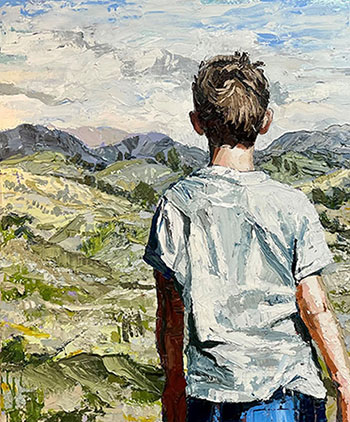
Recognised as a narrative painter, Sydney-based Tanya Chaitow’s current exhibition is informed by an exploration of the work of the Old Masters, particularly the European paintings from the 18th and 19th centuries where the upper classes are portrayed in bucolic landscapes. Her interest in this era stemmed from a time when she was working directly […]
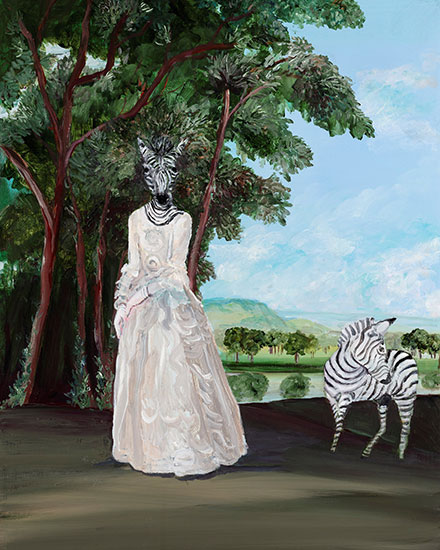
On the remote North West coast of Tasmania, a small but spectacular peninsula juts out into the expanse of Bass Strait. Here lies the historic township of Stanley that Elaine Green now calls home. Visiting the area a few years ago she’d had an epiphany. ‘While on a holiday exploring Tassie, we’d stopped in Stanley for a couple of days. Strolling along the beach there one morning I suddenly wanted to stay forever!’ Elaine’s current body of work depicts that immersive experience of place. Akin to 19th century Romanticism, her concern is with the intangible qualities; conditions of sky, light and atmosphere – the ever-changing drama of wind, water and clouds, the sweeping forces of nature.
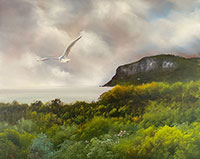
Many of us would acknowledge that we have an old box of memorabilia stored away that we promise ourselves to sort through one of these days. Di West’s current body of works has been inspired by doing just that. Five years ago, she packed up and relocated from Brisbane to the Bay of Islands, New Zealand. Her family had moved from that country to Queensland when she was three years old and became the publicans of the heritage-listed Plough Inn Hotel in Southbank. Her grandfather was licensee of the now demolished Currumbin Hotel, all her school holidays were spent in that locale.

Once upon a time the world seemed younger and magic glimmered in shady bowers or radiated from windswept skies and seas ablaze with vivid hues. The art of Melissa Egan reopens a portal into storylands where all gravity has been cancelled and anything is possible. The titles of the exhibition and many of the works therein, indicate a ‘Sound of Music’ inspiration. Delightful, humour-tinged scenarios dance from the tip of Egan’s brush and we, like the von Trapp children accompanying Maria, follow her into the boundless realms of imagination to discover ‘a few of her favourite things’.

A sense of quietude pervades Robyn Sweaney’s new body of work. The mood is one of introspection and stasis. She explains that her current paintings were created amidst ‘a year of uncertainty and the complexities of a world where our collective experience of multiple lockdowns, orders to ‘stay at home’ and be ‘alone together’ have become the new normal’. The exhibition’s title, Long Road Home, references memories of pre-2020 excursions from Mullumbimby to visit family and the Victorian landscapes of childhood, as well as a 2012 residency in Broken Hill. ‘The vistas and dwellings I had encountered along the way were quite literally, a long way from home!’ remarks Sweaney. ‘More than just reflections on my travels, the imagery embodies the larger issues we’ve all faced. It is about distance, but also love, longing and hope.’
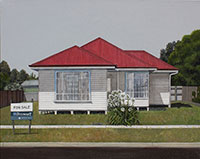
Two very different creative approaches are evident in David Green’s current exhibition. Large, incredibly intricate, dip-pen and ink drawings, that take months to complete, are juxtaposed alongside small, gestural and collaged evocations. ‘When I finish a big drawing, I need to clear my head, so I’ll spend a period of time just having fun,’ Green remarks. ‘My work has always fluctuated between fine line and broad brushstrokes; between drawing, drawing/embroideries and painting,’ he furthers. Green relays that this is in all probability a consequence of working as a freelance textile designer in his early days. A constant changing of styles was required to meet the various companies’ niche markets.

A conversation may be defined as an exchange of sentiments, observations and ideas. Buderim-based Veronica Cay’s new body of works reflects a ruminative dialogue with her materials and subject depiction, as well as certain historical art pieces. The drawings, canvases and ceramic figures portray the imaginary conversations that she’d loved to have shared with an adventurous aunt but lacked the opportunity. The aunt had led quite an extraordinary life. In 1936, at the age of 15, she left a very conservative family in Toowoomba to attend Sydney’s National Art School never to return home.

Working from her studio in the hills behind the small northern NSW town of Mullumbimby, Avital Sheffer creates profoundly beautiful vessels that have attracted international recognition. An exhibition of Sheffer’s hand-built ceramic art resonates the atmosphere of a sacred space. The forms may be thought of as portals between realms past and future, temporal and spiritual. Sheffer tells that the title for her current body of work ‘refers to the capacity of vessels to tell stories, to store knowledge, to keep records of place and time. There is inherent poetry in such intimate, yet collective memory. I perceive material and spirit as inseparable.’
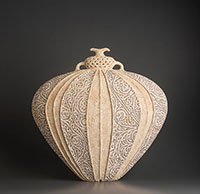
Robert Ryan’s new series of works again engages the viewer in a poetic linking of humanity and the natural world. Picture surfaces pulse with linear activity and an astounding array of biomorphic shapes. Sociological and ecological implications are ever present. The exhibition’s title, I Found an Old Box of Paint, may seem curious but Ryan imparts that it has both a metaphorical and quite literal relevance.
‘I opened an old carton of oil paints that I had discovered during the packing up of my print studio below the Barebones Gallery in Bangalow,’ he explains. ‘Long forgotten, it had been stored away when I was preparing to go overseas in the early 2000’s. Some of the tubes would have been from the mid 90’s… a lot of memories in that box!’

Receive e-mail updates on our exhibitions, events and more
Subscribe Now